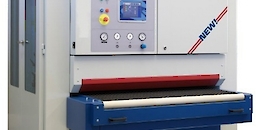Calibrated sanding machines are mainly produced for two main processes. The first one is the calibration process; that is, homogenously bringing the thickness of the material to be processed to a single dimension, and the second is sanding; that is to ensure surface cleanliness. Calibrated sanders can only do any of these operations, but they can do both. Only calibrating machines are called calibrating machines, while both calibrating and sanding machines are called calibrated sanding machines.
Calibrated sanding machines are basically machines that cannot be set to a certain standard and should be manufactured in accordance with the job they will be used upon request. This enables efficient operation of the machines.
Basically, the operating principles can be described as grinding the surface to be treated by means of variable thickness sanding belts rotating around rollers of varying stiffness and providing surface cleaning by other units (pressure pads, etc.) that may be added. Therefore, whatever the process is to be carried out, the units (rollers) on the machine and the sanding belts to be used in these units should be selected accordingly. For example, if the process is calibration; roller hardness and sanding belt thickness should be increased, if the process is precision sanding, roller hardness and sanding belt thickness should be reduced and a pressure pad (rigid, pneumatic, piano, etc.) appropriate to the sensitivity of the work should be added. The number of roller units must be increased in proportion to how many cycles the work is desired to finish. Another consideration is the height of the sanding belt. The sooner a sanding belt touches the surface to be treated, the sooner it contacts the pores, the faster the pores and the surface loses its precision. Therefore, the sanding belt height relative to the width of the machine should also be as close as possible to the maximum possible extent.
Basic uses of calibrated and calibrated sanding machines; Calibration and sanding of raw materials (solid, chipboard, MDF, etc.), calibration and sanding of coated materials, sanding of polished, varnished or painted surfaces.
I would like to explain two general examples in order to bring the subject to a more comprehensible level.
In our first example, let us consider a medium-sized enterprise producing wooden doors and solid furniture. Let us assume that this enterprise uses solid, raw or coated chipboard and MDF as raw material. The places where the calibrated sanding machine will be used in such an enterprise; calibration of the raw material and recalibration of the surface coated material after calibrating and precision sanding. In this case, the required machine is a calibrating unit whose first unit consists of a hard (eg 90 cores) roller and 80 grit sanders, while the second unit is a calibrating sander comprising a softer (e.g. 40 cores) roller and a relatively thinner sanding unit such as 120 grit. A suitable pressure pad should be added to the sanding unit according to the veneer and material thickness used. If non-standard, thin veneers are adhered to thin materials (for example thin veneer less than 10 mm to 0.8 mm thin parts), the piano pressing pad (consists of keys that each press differently on the sanding belt according to the surface thickness it perceives by means of independent sensors), if thick If thick, standardized veneers are adhered to the materials, the pneumatic pressure pad (works as a rigid or air cushion in the ratio of air filled into it according to the surface to be treated) should be selected.
In our second example, let’s consider an enterprise that wants to sand the painted surfaces. In this case the necessary machine; the first unit is a sanding unit consisting of a roller of medium hardness (eg 45 shor) and a fine sandpaper, the second unit is a much finer sanding (such as 120, 200, 400 or 600 grit) which can be selected according to a softer (eg 30 shor) sanding machine. Since surface sensitivity is very important in this machine, the pad to be used must be strictly piano system. In addition, the output of the machine as a final process scotch bride should be called a brush unit. Since the surfaces to be processed are painted and it is of utmost importance to ensure surface sensitivity, the machine’s feeding belt is vacuum (vacuum unit that secures with suction power in order to prevent the work piece from moving and thus scratching), the feed belt speed should be variable adjusted by inverter, and the rotation speed of the sanding rollers should be variable adjusted by inverter. there should also be an air blower that cleans the abrasives to avoid dust that could cause scratches on the surface. To ensure easy operation of all these units, the machine must be operated with an NC control system.
It is possible to reproduce these examples in numerous proportions.
Our esteemed customers better and with the principle of providing quality service moving company AS METAL Turkey made the general distributor and expert in Italian, SBF Stefani and CB works are exhibited in calibrating sanding machines branded stores in our state. Please do not hesitate to call us for more information.
Yours truly,
Gürkan NECİPOĞLU
Other News
You can follow our most up-to-date shares in the field below.



